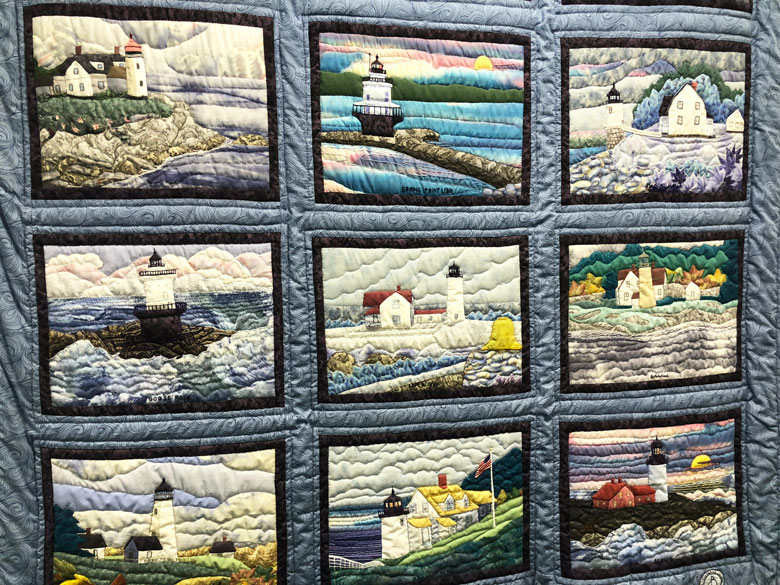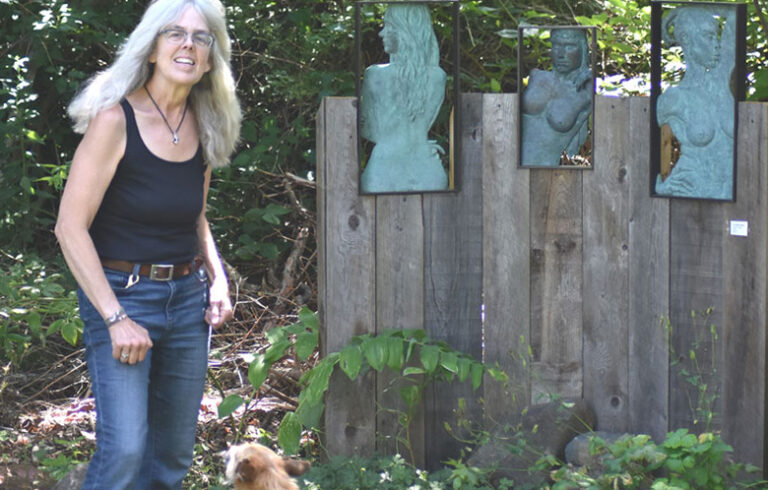I am not much of a historian. I spend most of my days thinking about the future and how to work with Maine’s coastal communities to prepare for and adapt to what’s to come. This summer, however, I’ve had the opportunity to delve into some meaningful stories from our 40-year history. An unlikely source took me on a journey: a quilt.
Every day I’m in the office, I walk by an extraordinary quilt that decorates one of our walls. This isn’t just a pretty quilt; it is a piece of art, with carefully hand-dyed and painted material, fine embroidery, and neatly stitched appliqué. Each of the squares is a colorful representation of the lighthouses that dot our coast from West Quoddy Head to Spring Point Ledge.
While I had admired the craftsmanship, I hadn’t noticed until recently the decorations in the bottom corners of the quilt: the Chebeague Island Historical Society logo and the perfectly hand-embroidered signature by the artist, Shirley Burgess.
It took an act of Congress and some well-placed support from then Sen. George Mitchell to seal the deal…
In fact, this quilt came to Island Institute as a recognition of its efforts in the early 1990s to secure the future of Maine lighthouses. Lighthouses all along the coast were facing demolition by the U.S. Coast Guard as coastal navigation became automated. With no need for lighthouse keeper homes, or the lighthouses themselves, these sentinels of the coast were at risk of disappearing forever.
Enter the Maine Lights program. Through this program, conceived and initiated by our co-founder, Peter Ralston, several of those lighthouses came directly to Island Institute and we, in turn, ensured they were transferred into the hands of groups committed to preserving the lighthouses and ensuring public access.
It took an act of Congress and some well-placed support from then Sen. George Mitchell to seal the deal, resulting in the transfer of 27 lighthouses into caring hands. The sale of Jamie Wyeth prints helped facilitate the costs of transfer.
Although lighthouses had become a capital expense for the government, their spiritual value to local communities has never waned.

Like many, quilt-artist Shirley Burgess felt a personal connection.
“How many of us wouldn’t be here on Chebeague today if it weren’t for the lights?” she wondered. The quilt that hangs at Island Institute is emblematic of that deep connection between coastal communities and our maritime history—15 squares representing the trust between seafarers and lighthouse keepers and the lives saved through that partnership.
Shirley gifted the quilt to the Chebeague Historical Society, which in turn gifted it to Island Institute. As Donna Damon, one of our board members at the time said, people “have a hard time understanding why one nonprofit would donate to another, but it’s part of island culture. All groups are related, one group of people to another.”
Ultimately, the Maine Lights Program formed the basis for the National Historic Lighthouse Preservation Act, which earned Peter Ralston the “Keeper of the Light” award from the American Lighthouse Foundation and cemented Maine’s role in this important effort.
Knowing its history, I view that quilt today in a different light, as the daughter of a Navy veteran, as a resident of Chebeague Island, and as the president of Island Institute.
We are all, in fact, keepers of the light through our connections to each other, ensuring that future generations have safe passage and that Maine continues to light the way. As Shirley’s son, Ernie Burgess, so aptly put it in a 1995 interview, “lighthouses look awful, awful good when you’re not sure where you’re going…”
Kim Hamilton is president of Island Institute, publisher of The Working Waterfront. She may be contacted a khamilton@islandinstitute.org.





